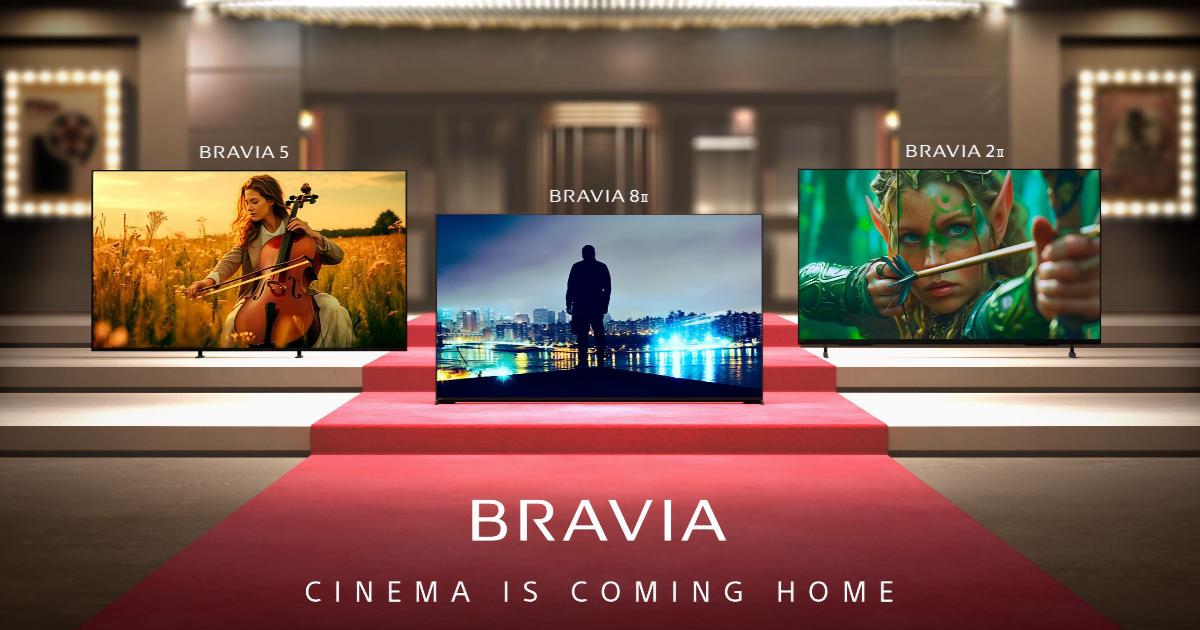Sony goes back to QD-OLED for its 2025 flagship Bravia 8 II TV

Following its launch of the Bravia 9 miniLED TV in 2024, Sony’s 2025 flagship model seemingly takes a step back to a QD-OLED Bravia 8 (albeit with a II moniker added).
We asked Sony about the future of miniLED displays and they answered that their focus on mini-LED remains, and BRAVIA 9 continues to be Sony’s flagship model, delivering flagship-level quality not only through its proprietary backlight control technology and processor-driven picture quality but also in terms of sound quality, user experience, and environmental considerations.
There are three new Bravia TV models for 2025. The flagship Bravia 8 II (available in 55-inch and 65-inch models), BRAVIA 5 (available in 55-inch, 65-inch, 75-inch, and 98-inch models), and the BRAVIA 2 II (available in 43-inch, 50-inch, 55-inch, and 65-inch models). Additionally, Sony is also launching a new Bravia Theatre home cinema system, soundbar and optional speakers.
All of the TVs in the Bravia series come equipped with what Sony calls its Studio Calibrated modes that are programmed to reproduce the image quality intended by film content creators in a home setting. The three included modes are the Netflix Adaptive Calibrated Mode, Sony Pictures Core Calibrated Mode, and the Prime Video Calibrated Mode.
“With the addition of BRAVIA 8 II, 5 and 2 II this year, we believe our line-up is now complete (together with the 2024 introduction), allowing a wider range of customers to enjoy their beloved content with the series that best suits their needs,” their spokesperson said.
Sony Bravia 8 II: QD-OLED leads the way

Following on from the 2024 Bravia 8 and its WOLED display, the 2025 Sony Bravia 8 II goes for a QD-OLED display that Sony says its peak brightness is increased 25% when compared to the A95L, which was also a QD-OLED display.
Like the Bravia 9 from 2024, the Bravia 8 II gets Sony’s proprietary XR Processor, which is a cognitive intelligence-powered graphics and processing unit that analyses the content and sets out to recreate it based on human perception of images and sound. XR OLED Motion spots key objects in each frame and compares them to the next frame to see how they move. It then creates new frames in between, making the movement smoother.
Nothing comes without some form of AI these days, so the Bravia 8 II also features an AI scene recognition system that detects and analyses the data on the screen, then optimises the picture to achieve realism. This TV uses XR Contrast Booster to control the light to deliver depth and detail.
In the sound department, it has the now familiar Acoustic Surface Audio+ that turns every part of the screen into a speaker that emits sound from the right place in the scene. Sony’s Voice Zoom 3 recognises human dialogue through AI machine learning and adjusts the volume of voices, making them louder or softer as needed
Trickling down into the Bravia 8 II from the Bravia XR Master Series A95L OLED TV is Sony’s XR Triluminos Max technology, which enhances the colour reproduction by accessing a wider colour palette and reproducing natural shades with every detail, resulting in a more vivid and realistic picture.
Sony’s “Slim One Slate” concept used for the Bravia 8 II series, aims for a minimalist aesthetic by fusing the screen and bezel into a single, ultra-thin slate, maximising the viewing experience and blending seamlessly with the wall.
In terms of standards support, the Bravia 8 II comes with Dolby Vision, Dolby Atmos, IMAX Enhanced, and DTS: X.
Sony Bravia 5: the new kid on the block

The Sony Bravia 5 is a new series introduced this year and targets consumers who demand picture quality. The Bravia 5 comes in sizes up to a 98-inch option to satisfy those seeking large screen sizes, to let the cinematic experience shine in the comfort of the home. Powered by Sony’s XR Processor (like the Bravia 8 II) it forms the backbone of the technology powering the TV.
It is equipped with Sony’s XR Backlight Master Drive that delivers local dimming for controlled contrast. It captures light and shadow using precise gradation, from subtle facial shading to bold highlights.
Sony’s XR Triluminos Pro technology enhances colour reproduction by expanding the colour spectrum and using a wider palette of colors, resulting in more natural and lifelike visuals, especially for HDR content, capturing subtle shades and hues for a more realistic viewing experience.
It also uses XR Clear Image intelligently to upscale your favourites to near-4K, adjusting processing based on the original content’s quality. This ensures natural textures and details to shine through, while dynamic frame analysis and zone division work to minimise noise on screen.
Sony’s One Slate design aims for simplicity, allowing users to focus on the viewing experience, and content is available for the Bravia 5 series (except the 98-inch model). Like the Bravia 8 II, the Bravia 5 supports Dolby Vision, Dolby Atmos, IMAX Enhanced, and DTS: X.
Sony Bravia 2 II: Teaching an old boy new tricks

The Sony Bravia 2 II comes with Sony’s 4K X-Reality Pro. This upscales HD content to almost 4K quality, revealing sharper textures and lifelike clarity, all in real time.
The Bravia 2 II supports DTS: X and Dolby Atmos, which is absent in its predecessor (specifications may vary between regions). Furthermore, it comes with four HDMI ports instead of three, and has improved bezel slimness, achieving a more flush and slim look.
Unlike the Bravia 5 and Bravia 8 II, the Bravia 2 II uses a Flush Surface design to fit into a living space.
For its gaming support, the Bravia 2 II has Auto HDR Tone Mapping that instantly optimises HDR settings during your PS5 and PS5 Pro console setup phase. When it detects a PS5 or PS5 Pro getting turned on, it automatically switches into Game Mode to minimise lag and maximise responsiveness. Use the PS Remote Play app to control your PS5, PS5 Pro or PS4 console from another room or even another location.
Pair them with a Bravia Theatre home product

To go with the three new TV models, Sony has released three new Bravia Home Theatre products to support them.
The new range includes the Bravia Theatre Bar 6 (3.1.2ch soundbar with a wireless subwoofer for a standalone immersive cinematic audio experience), the Bravia Theatre Rear 8 (rear speakers) and the Bravia Theatre Sub 7 (a sub speaker addon option for connection to a compatible soundbar).
Use the Bravia Connect app to control both your Bravia TV and Bravia Home Theatre from your smartphone. Adjust volume and settings, and even check your set-up without using the remote or on-screen menu. You can even control both on a single screen without switching remotes or the app. Alternatively, it is possible to control features such as sound field and volume using just the TV remote. With an integrated UI, soundbar sound settings automatically appear on the Bravia Quick Settings menu.
Pricing and availability

Sony says that the Bravia 8 II, Bravia 5, and Bravia 2 II will be available in Singapore at selected retail shops and online stores from May 2025 onwards, at the following retail prices:
Sony 2025 Bravia Pricing
| Model | Price |
|---|---|
| Bravia 8 II K-55XR80M2 | S$4,399 |
| Bravia 8 II K-65XR80M2 | S$6,299 |
| Bravia 5 K-55XR50 | S$3,199 |
| Bravia 5 K-65XR50 | S$4,199 |
| Bravia 5 K-75XR50 | S$6,299 |
| Bravia 5 K-98XR50 | S$12,999 |
| Bravia 2 II K-43S20M2 | S$1,299 |
| Bravia 2 II K-50S20M2 | S$1,499 |
| Bravia 2 II K-55S20M2 | S$1,699 |
| Bravia 2 II K-65S20M2 | S$2,099 |
All of the new Bravia Home Theatre products will be available in Singapore from July this year. The Bravia Theatre Bar 6 will be priced at S$999, while the Bravia Theatre Rear 8 and the Bravia Theatre Sub 7 will be priced at S$549 and S$399, respectively.



